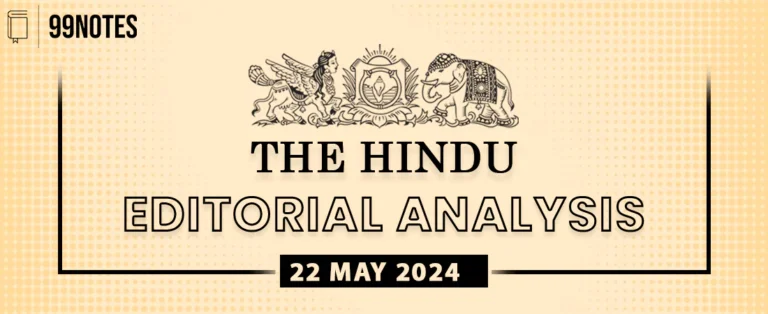9 March 2024 : The Hindu Editorial Notes PDF
The Hindu Editorial
9-March-2024
1. India’s suboptimal use of its labour power
| Topic: GS3 – Indian Economy – Issues related to development and employment Critical for UPSC as it delves into India’s labour dynamics, highlighting nuances beyond GDP, crucial for holistic economic understanding. |
| Context |
|
Introduction:
- The majority of Indians rely on labour for income, with 90% engaged in informal employment lacking job security and benefits.
- GDP growth headlines often overshadow the critical factor of labour market dynamics in determining the well-being of the masses.
Improvements in Labour Force Participation:
- The Labour Force Participation Rate (LFPR) has increased from 52.35% in 2017-18 to 58.35% in 2021-22, mainly driven by rural women.
- Overall unemployment rates have declined, from 6.2% in 2017-18 to 4.2% in 2021-22, with a similar trend for youth unemployment.
Composition of Employment Types:
- A deeper analysis reveals that the rise in LFPR and the drop in unemployment are predominantly attributed to the growth in self-employment.
- Within self-employment, unpaid family workers have significantly increased from 26% to 31.4%, surpassing the marginal rise in employer-driven self-employment.
- Own-account workers, such as small business owners or street vendors, constitute nearly 35% of the employed population.
Quality of Jobs and Workforce Composition:
- The proportion of regular wage/salaried employees, casual labourers, and employers has decreased between 2017-18 and 2021-22.
- The most significant rise in employment is seen in unpaid family labour and own-account workers, signalling a potential decline in job quality.
- This shift reflects a worrisome trend in the nature of work, emphasising the precariousness of the informal employment sector.
Earnings Scenario:
- The overall average real daily earnings increased by approximately ₹10 (4%) between 2017-18 and 2021-22.
- Both rural and urban daily earnings experienced a slight increase, with wage and salaried workers having the highest average earnings, followed by the self-employed and casual workers.
- Despite the increase, average earnings for the self-employed and salaried workers stagnated in real terms.
- Casual workers saw a notable 20% increase in daily earnings, but their monthly income remains close to or just above the poverty line.
Concerns for Economic Growth and Demographic Dividend:
- The rise in LFPR and the decline in unemployment, while seemingly positive, are overshadowed by the predominant growth in low-quality self-employment.
- More than three-quarters of the employed population engages in low-productivity work, impacting the potential benefits of India’s demographic dividend.
- Stagnant earnings, especially for the poorer sections, may hinder consumer expenditure, contributing to a potential economic downturn.
Conclusion:
- While some headline economic indicators show positive trends, a closer examination of the labour market reveals concerns about job quality, earnings, and their impact on economic growth.
- Addressing the challenges in the composition of employment and the quality of work is crucial for sustaining a positive trajectory in India’s economic development.
| India’s suboptimal use of its labour power and impact on demographic dividend |
In conclusion, India’s suboptimal use of its labour power stems from educational disparities, dominance of the informal economy, underemployment, gender imbalances, policy challenges, and global competition. Addressing these issues is crucial for unlocking the full potential of the demographic dividend and ensuring sustainable economic growth. |
| PYQ: Economic growth in the recent past has been led by increase in labour productivity. Explain this statement. Suggest the growth pattern that will lead to creation of more jobs without compromising labour productivity. (UPSC CSE (M) GS-3 2022) (250 Words /15 marks) |
| Practice Question: Critically examine the recent trends in India’s labour market (2017-18 to 2021-22). Analyse the implications of these trends for inclusive growth and India’s demographic dividend. (250 Words /15 marks) |
2. Gender equality as the plank of sustainable development
| Topic: GS2 – Social Justice – Vulnerable Sections Crucial for UPSC: Links gender equality, energy sustainability, and SDGs, reflecting interconnected global challenges and policy imperatives. |
| Context |
|
Introduction:
- Ongoing discussions emphasize gender equality and women’s empowerment as crucial societal goals.
- The intersection between gender equality and sustainable energy development is often overlooked but plays a pivotal role in achieving Sustainable Development Goals (SDGs).
Interconnected SDGs:
- SDG5 (gender equality), SDG7 (clean, affordable energy), and SDG12 (climate action) are interlinked, highlighting the integral role of gender equality in sustainable development.
Role of Women in Energy:
- Women significantly contribute to energy access, production, and consumption.
- Barriers limit women’s participation in the energy sector, hindering economic growth and environmental sustainability.
Energy Access Disparities:
- Women often manage household energy, but energy infrastructure tends to reach them last.
- Lack of access to modern energy forces reliance on harmful alternatives, contributing to health risks and perpetuating energy poverty.
Health Impacts:
- Household air pollution from traditional energy sources leads to 3.2 million premature deaths annually, with 60% affecting women and children (World Health Organization).
Gender Disparity in the Energy Sector:
- The energy sector remains one of the least gender-diverse, with women constituting 32% in renewables and 22% overall, compared to 48% globally.
- In India, only 10% of women hold technical posts in the energy sector (International Energy Agency).
Factors Contributing to Gender Disparity:
- Educational disparities, limited technical training opportunities, and inequitable company policies contribute to the gender gap.
Addressing Challenges:
- Shifting perceptions about women’s roles in the energy sector is crucial.
- Governments, non-state actors, and international institutions must collaborate to mainstream gender in energy policies.
Initiatives Driving Change:
- Programs like Women at the Forefront and Energy Transitions Innovation Challenge promote women’s participation in sustainable energy.
- Distributed Renewable Energy (DRE) initiatives, such as Solar Mamas in India, empower women by providing affordable energy access and skills training.
Economic Impact:
- Closing the gender gap in employment and entrepreneurship could boost global GDP significantly.
- Women’s participation in the energy sector leads to innovative solutions, increased productivity, and positive social and environmental outcomes.
Case Study:
- Powering Livelihoods’ report indicates that over 71% of early adopters of clean technology livelihood appliances in India, totaling over 16,000, are women.
Conclusion:
- Empowering women in the energy sector is not just morally right but also a strategic investment for global development.
- Recognizing women as key agents of change in the energy sector leads to a more inclusive, prosperous, and sustainable world.
| PYQ: Women empowerment in India needs gender budgeting. What are the requirements and status of gender budgeting in the Indian context? (200 words/12.5m) (UPSC CSE (M) GS-3 2016) |
| Practice Question: Discuss the significance of integrating gender equality into sustainable energy policies for achieving comprehensive development goals. (150 Words /10 marks) |
For Enquiry

9 March 2024 : Daily Current Affairs

9 March 2024 : Indian Express Editorial Analysis

9 March 2024 : The Hindu Editorial Notes PDF

9 March 2024 : PIB Summary for UPSC

8 Mar 2024 : Daily Current Affairs Quiz

8 Mar 2024 : Daily Answer Writing

8 March 2024 : Daily Current Affairs

8 March 2024 : The Hindu Editorial Notes PDF

8 March 2024 : PIB Summary for UPSC

8 March 2024 : Indian Express Editorial Analysis
Daily Current Affairs 9 March 2024 : Daily Current Affairs Daily Current Affairs
9-March -2024- Top News of the Day
1. ECI’s Proposal to Remove Aadhaar Linkage…
Indian Express 9 March 2024 : Indian Express Editorial Analysis Indian Express Editorial Analysis
9-March-2024
1. Change in the Valley
Topic: GS2 – Governance –…
March – The Hindu Editorial 9 March 2024 : The Hindu Editorial Notes PDF The Hindu Editorial
9-March-2024
1. India’s suboptimal use of its labour power
Topic: GS3 – Indian…
March 2024 PIB 9 March 2024 : PIB Summary for UPSC PIB Summary for UPSC
9-March -2024
1. India receives ‘Measles and Rubella Champion’ Award for Exemplary…
Daily Quiz 8 Mar 2024 : Daily Current Affairs Quiz 8 Mar 2024 : Daily Quiz…
mains answer writing 8 Mar 2024 : Daily Answer Writing Mains Answer Writing
8-March-2024
Q1) The role of civil services as an enabler of development and an…
Daily Current Affairs 8 March 2024 : Daily Current Affairs Daily Current Affairs
8-March -2024- Top News of the Day
1. India to Restart Penicillin G Manufacturing…
March – The Hindu Editorial 8 March 2024 : The Hindu Editorial Notes PDF The Hindu Editorial
8-March-2024
1. A bold step towards a cervical cancer-free future
Topic: GS2…
March 2024 PIB 8 March 2024 : PIB Summary for UPSC PIB Summary for UPSC
8-March -2024
1. Cabinet approves Uttar Poorva Transformative Industrialization…
Indian Express 8 March 2024 : Indian Express Editorial Analysis Indian Express Editorial Analysis
8-March-2024
1. The bias that must go
Topic: GS1 – Society – Role…





